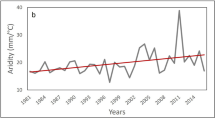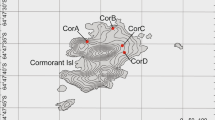Summary
The phenology of the Californian shrub, Diplacus aurantiacus has been shown to be closely tied to habitat water availability, and the life cycle of the checkerspot butterfly, Euphydryas chalcedona, is in turn tied to the phenological development of Diplacus. Here this relationship is further documented by showing how the activity patterns of both the shrub and the butterfly vary from year to year, but in synchrony, dependent on the breaking of the annual drought.
The end of the feeding period for the post-diapause larvae coincides with flowering of Diplacus. At this time the quality of leaves as a food source for the larvae declines as nitrogen evidently moves from the leaves into plant reproductive parts.
The abundance of leaves available as food for the larvae varies greatly with season. The few leaves present during the drought period, when the larvae are inactive, are low in nitrogen and high in resin content. Even during this period, though, these leaves contribute to the carbon economy of the plant. Of the leaves produced during the principal growing season, it is the youngest leaves with the highest nitrogen contents, and hence greatest potential carbon-gaining capacity, that have the highest resin contents. Larvae feed preferentially on the older, lower-resin-content leaves. It can be surmised thus that resin is a feeding deterrent and that its distribution within the plant results in the greatest protection of the plant's carbon-gaining capacity.
Similar content being viewed by others
References
Mooney HA, Ehrlich PR, Lincoln DE, Williams KS (1980) Environmental controls on the seasonality of a drought-deciduous shrub, Diplacus aurantiacus and its predator, the chekerspot butterfly, Euphydryas chalcedona. Oecologia (Berl) 45:143–146
Brown IL, Ehrlich PR (1980) Population biology of the checkerspot butterfly, Euphydryas chalcedona. I. Structure of the Jasper Ridge colony. Oecologia (Berl) in press
Lincoln D (1980) Leaf resin flavonoids of Diplacus aurantiacus., Biochemical Systematics and Ecology 8:397–400
Lincoln DE, Newton TF, Ehrlich PR, Williams KS (1980) Coevolution of the checkerspot butterfly Euphydryas chalcedona and its larval food plant Diplacus aurantiacus: Larval response to variation in protein and leaf resin. In manuscript
Gulmon SL (1981) Carbon and nitrogen economy of a Californian mediterranean-climate drought-deciduous shrub. In: F Kruger, DT Mitchell, and J Jarvis (eds) Mediterranean-Type Ecosystems. The Role of Nutrients, Springer, Berlin Heidelberg New York
Author information
Authors and Affiliations
Additional information
Dedicated to Dr. Konrad Springer who has been a strong force in the development of ecology this past decade through his prolific publication series which have set the highest standards in the profession
Rights and permissions
About this article
Cite this article
Mooney, H.A., Williams, K.S., Lincoln, D.E. et al. Temporal and spatial variability in the interaction between the checkerspot butterfly, Euphydryas chalcedona and its principal food source, the Californian shrub, Diplacus aurantiacus . Oecologia 50, 195–198 (1981). https://doi.org/10.1007/BF00348037
Received:
Issue Date:
DOI: https://doi.org/10.1007/BF00348037




